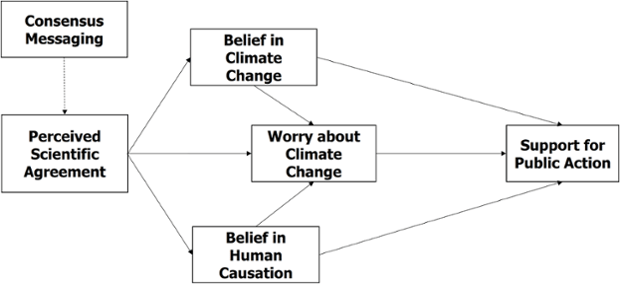
Everyone agrees that global warming has become a polarized issue. Liberals tend to view themselves as being on Team Human-Caused Global Warming is a Problem, and conservatives tend to view themselves on Team No It’s Not. Convincing people to change their beliefs and leave their cultural group is a challenge with any polarized subject.
When it comes to climate change, the scientific evidence falls squarely behind the first team, and so the question becomes how we reduce the polarization that makes so many people culturally identify with second team. That’s a question social scientists have been grappling with for years.
One suggested approach involves consensus messaging – telling people about the 97% expert consensus on human-caused global warming. People tend to badly underestimate the expert consensus on this issue, and research has shown that communicating the 97% consensus makes people more likely to accept the scientific reality of human-caused global warming and the need to do something about the threats it poses.
increasing public perceptions of the scientific consensus causes a significant increase in the belief that climate change is (a) happening, (b) human-caused and (c) a worrisome problem. In turn, changes in these key beliefs lead to increased support for public action. In sum, these findings provide the strongest evidence to date that public understanding of the scientific consensus is consequential.
The study illustrates “the gateway belief model” in the following figure.
In the study, the scientists asked people to rate their beliefs about these key issues before and after being told about the 97% expert consensus. The results validated the model. Subjects’ perceived expert consensus increased dramatically, and their belief in climate change, its human causation, concern about it, and support for public action all increased as well.
The increase in concern about climate change is a key result. Most people, including a majority of Republicans, support taking action to slow global warming. But they view it as a low priority, so they don’t mind when policymakers fail to take action. Hence there’s no penalty for climate denial in Congress, whereas there’s a big financial reward from the fossil fuel industry for delaying climate action. That calculation won’t change until people view tackling global warming as a higher priority. This study suggests that consensus messaging may help people grasp the importance of the problem.
The gateway belief model makes sense because people don’t have the time to learn about every important issue, so we often defer to the experts. As shown by a 2013 study led by Stephan Lewandowsky,
when in doubt about scientific facts, people are likely to use consensus among domain experts as a heuristic to guide their beliefs and behavior.
Dan Kahan at Yale is also a social scientist, and has argued that consensus messaging is “counterproductive” and “deepens polarization.” However, both Lewandowsky’s research and this new study find that consensus messaging “neutralizes the effect of worldview” because “Republican subjects responded particularly well to the scientific consensus message.” Especially when they saw it in pie chart form.
The problem, as Andy Skuce notes in detail at Skeptical Science, is that the fictional article bears little resemblance to the realities of geoengineering. The technologies are described as “more effective than enactment of emissions restrictions” and would “spare consumers and businesses from the heavy economic costs associated with the regulations necessary to reduce atmospheric CO2 concentrations”.
In reality, proposed geoengineering technologies are generally very expensive, would require international cooperation and regulation, and are extremely risky. As Skuce notes, even the scientists who are among the biggest advocates for geoengineering research agree that the technologies entail high risks, and their implementation should only be considered in the event that we first fail to mitigate global warming through carbon pollution reductions and have become desperate to slow rapid climate change.
If the Earth’s climate were a car, right now we’re already driving dangerously fast and accelerating. Carbon pollution cuts would be the brakes, and geoengineering would be the airbags. Kahan’s experiment tells people that we don’t need to use the brakes because the airbags will protect us, and we can have fun going fast in the meantime.
Posted by dana1981 on Tuesday, 10 March, 2015
 |
The Skeptical Science website by Skeptical Science is licensed under a Creative Commons Attribution 3.0 Unported License. |